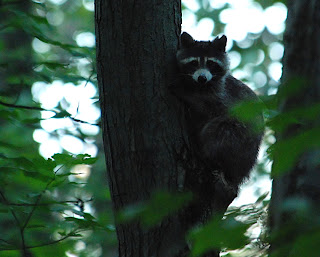They're being lazy bastards.. but also......
feed on acorns and other stuff high up in the canopy! While I was walking on a track through the forest I suddenly heard some nuts dropping on the ground. I looked up but saw nothing, a moment later I saw an entire brench falling down. I looked with my binocular and found a Raccoon feeding high up in the canopy. When I looked better I could even see 4-5 Raccoons feeding. They had put their fat bodies in such a way that they wouldn't have to move to get some food: lazy mammals. Around 19.00 in the evening the Raccoons start to get more active and start to look for some more food. They do a bit of walking, passing roads, getting killed by cars or whatsoever. On my way back to my cabin however I saw 2 Raccoons passing the road without getting hit, highly expectional! I cycled towards them and saw them climbing in a tree. They kept an eye on me while I was photographing them:
Ok, now back to the banding. Today was a good day considering the weather conditions. It was really windy at arrival, with a strong wind blowing from an easterly direction, at least 4 bft. We were glad though that the wind died down after the sunrise and it was quite pleasant outside. By noon the wind had gone strong again so we had to close the nets a bit early. The day ended with about 115 birds, 90 new ones spread over 28 species. I had one lifer today: the first Lincoln's Sparrow for the season. Another season's first was a Ruby-crowned Kinglet. 2 Flickers are also worth mentioning. The totals can be found below:
Ruby-throated Hummingbird 5 -
Northern Flicker 2 -
Yellow-bellied Flycatcher 2 -
Traill's Flycatcher 1 -
Red-eyed Vireo 2 -
Black-capped Chickadee 1 -
Tufted Titmouse 1 -
House Wren 1 -
Ruby-crowned Kinglet 1 -
Gray-cheeked Thrush 1 -
Swainson's Thrush 5 -
Gray Catbird 3 -
Tennessee Warbler 2 -
Chestnut-sided Warbler 3 -
Magnolia Warbler 12 - of which one partially albinistic (leucistic?)
Cape May Warbler 2 -
Black-throated Blue Warbler 6 -
Black-throated Green Warbler 4 -
American Redstart 4 -
Ovenbird 3 -
Common Yellowthroat 8 -
Hooded Warbler 2 -
Scarlet Tanager 3 -
Song Sparrow 1 -
Lincoln's Sparrow 1 -
Northern Cardinal 1 -
Rose-breasted Grosbeak 7 -
American Goldfinch 6 -
Total 90, 28 species
Lincoln's Sparrow, hatching year
Song Sparrow, hatching year; the first decent looking Song Sparrow I've seen so far (no wing or body moult)
Ruby-crowned Kinglet, after hatching-year female
Magnolia Warbler, after hatching-year (!) female; a very unusual appearance, this leucistic bird
And photographing a Gray Catbird is irresistible (ahum) so here is a pic!
Today was the last day of the workshop. Here a picture with the 5 workshoppers and Brandon. From left to right: Brandon, Ushi (don't know the spelling), Arnella, John, Charles and Julie. It was a really nice week for them in which they learned a lot about the ageing and sexing of birds.
Brandon was photographing this fine bird:
Cape May Warbler, after hatching-year male; some remaing orange and black feathers visible on the head.












Geen opmerkingen:
Een reactie posten